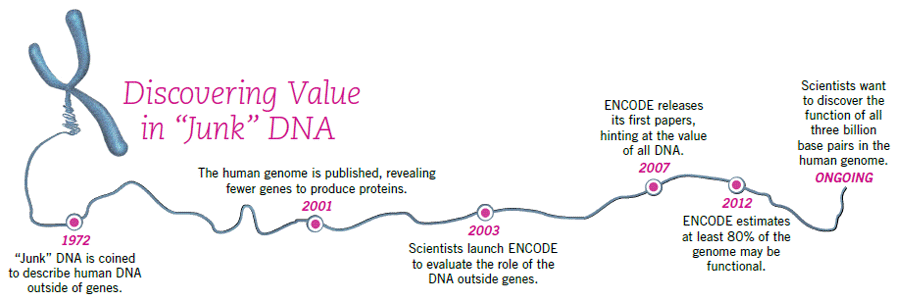
Decoding the Debris
Genetic Design
For decades, evolutionary scientists have ignored “junk” DNA that supposedly littered our genetic sequence. Now that they’ve finally realized their mistake, they’re opening new fields of discovery.
For decades most of the human genome (98 percent) has been considered “junk” DNA, with only about 2 percent coding for proteins. The geneticist Susumu Ohno first coined the term junk DNA in 1972. He stated, “The earth is strewn with fossil remains of extinct species; is it a wonder that our genome too is filled with the remains of extinct genes?”1
That perspective is changing radically. When the first version of the human genome was reported in 2001, scientists found far fewer genes than they had expected. (Genes are packets of information in the DNA responsible for making proteins.) Although nearly all cells in the body have the same DNA content, they need to make certain proteins at certain times and under certain conditions. What regulatory processes are keeping all this genetic activity straight? To answer that question, scientists needed to take a much closer look at the other 98 percent of human DNA.
The past decade of research has produced a cornucopia of surprises, forcing evolutionists to rethink their position on junk DNA.
The past decade of research has produced a cornucopia of surprises, forcing evolutionists to rethink their position on junk DNA. Yet the opposition among dyed-in-the-wool evolutionists remains fierce, continuing to hinder research into the secrets of the human body and the nature of disease.
A Decade of Discovery
In 2003 the ENCODE project (acronym for ENCyclopedia Of DNA Elements) was launched to begin evaluating the role of the non-protein coding DNA regions of the genome. In 2007 the ENCODE project released the first series of papers explaining their findings after analyzing just one percent of the human genome.2 Their initial findings were shocking—“junk” DNA was not junk; it was very likely functional!
In 2012, another series of papers was published, and the ENCODE project estimated that at least 80 percent of the genome is functional in the sense that it has “specific biochemical activity.” While this is a broad, general term that has stirred much debate, it indicates that researchers still have a lot to learn and understand. Much of the function is believed to be regulatory. In the simplest terms, the non-protein coding parts of the genome (formerly called junk) are telling the genes when to produce their products (the proteins) and a whole lot more.
The goal is to eventually figure out the function of each and every one of the three billion bases of human DNA.
The goal is to eventually figure out the function of each and every one of the three billion bases of human DNA. ENCODE researcher Tom Gingeras said, “Almost every nucleotide is associated with a function of some sort or another, and we now know where they are, what binds to them, what their associations are, and more.”3 Ewan Birney, ENCODE’s Lead Analysis Coordinator, said, “It’s likely that 80 percent will go to 100 percent.”4 In light of this evidence, it’s obvious that a more appropriate term for junk DNA is needed! In fact, ENCODE researchers themselves don’t even use the term junk DNA, but instead refer to these regions as non-coding DNA.
One obvious benefit of the ENCODE findings will likely be disease diagnosis and treatment. For many years scientists have known that certain variations in DNA (called single nucleotide polymorphisms, SNPs) are associated with risks for a disease or with the disease itself. But 90 percent of those variations fall outside of genes (they are in the junk DNA). Up to this point no one really knew how that variation was causing disease.
The ENCODE study found that 60 percent of these variations fall in regions that may affect the activity of genes. For example, the ENCODE study found five variations in patients with Crohn’s disease related to a specific factor that past researchers weren’t even looking at.5 Of course, translating the lab science into treatments will take time, but it puts scientists one step closer in the battle against disease in this sin-cursed world.
A third phase of the ENCODE project is now beginning to further refine exactly what all the junk DNA is doing. Ewan Birney stated, “We are the most complex things we know about. It’s not surprising that the manual is huge. I think it’s going to take this century to fill in all the details.”6
Undeterred Naysayers
For many evolutionists, the finding that junk DNA has function is inconsistent with an evolutionary worldview.
Although many scientists were thrilled about the newest ENCODE findings, there has also been opposition. For many evolutionists, the finding that junk DNA has function is inconsistent with an evolutionary worldview. It was assumed to be an evolutionary wasteland of sequences that were discarded as humans climbed the “tree of life” from a single-celled organism.
One popular argument against the idea that junk DNA has function is the so-called “onion test.” Evolutionary biologist T. Ryan Gregory states,
The onion test is a simple reality check for anyone who thinks they have come up with a universal function for non-coding [junk] DNA. Whatever your proposed function, ask yourself this question: Can I explain why an onion needs about five times more non-coding [junk] DNA for this function than a human?7
The common onion, Allium cepa, has a genome fives times as large as the human genome. The argument goes that if onions, which are much less complex than humans, have a lot of junk DNA that is not functional, then junk DNA in humans must not be functional either. Other onion species with smaller amounts of DNA can grow and survive quite well without the large amounts of DNA. So junk DNA in Allium cepa—and by analogy humans—is not functional.
But this is an argument from ignorance. Do scientists know that this DNA is not necessary for the onion? It’s possible that junk DNA is only necessary under certain environmental conditions, as onions don’t have the same choices as mobile organisms.
This is yet another example of how evolutionary ideas can inhibit scientific discovery. It is rather ironic that creationists are accused of inhibiting scientific discovery because of their supposed “God-did-it-so-there’s-nothing-more-to-study” mentality. In reality, the opposite is true. Creationists for many years have argued that junk DNA is not junk.
Once again we see that observational science is consistent with historical science based on God’s Word. Scientists have observed, tested, and discovered that “junk” DNA is key to genome function. This is consistent with an omniscient and omnipotent Creator God who designed and created all living things, including their DNA, during Creation Week approximately 6,000 years ago.
Creationists may look forward to the next installment of papers from the ENCODE project. Hopefully too, the term junk DNA will be discarded as evolutionary debris, and God’s design emphasized, as it always should have been.

Answers Magazine
July – September 2014
The summer issue looks at some of the earth’s most amazing rock features and explains how they formed quickly in the past few thousands of years.
Browse Issue SubscribeFootnotes
- Bob Kuska, “Should Scientists Scrap the Notion of Junk DNA?” Journal of National Cancer Institute 90 (1988): 1,032–1,033.
- For more information on ENCODE see, http://www .encodeproject.org/ENCODE/.
- Ed Yong, “ENCODE: The Rough Guide to the Human Genome,” Discover Magazine, September 5, 2012.
- Ibid.
- The ENCODE Project Consortium, “An Integrated Encyclopedia of DNA Elements in the Human Genome,” Nature 489 (2012): 57–74.
- Ed Yong, “ENCODE: The Rough Guide to the Human Genome,” Discover Magazine, September 5, 2012.
- T. Ryan Gregory, “The Onion Test,” Genomicron, April 25, 2007.
Recommended Resources

Answers in Genesis is an apologetics ministry, dedicated to helping Christians defend their faith and proclaim the good news of Jesus Christ.
- Customer Service 800.778.3390
- © 2024 Answers in Genesis





